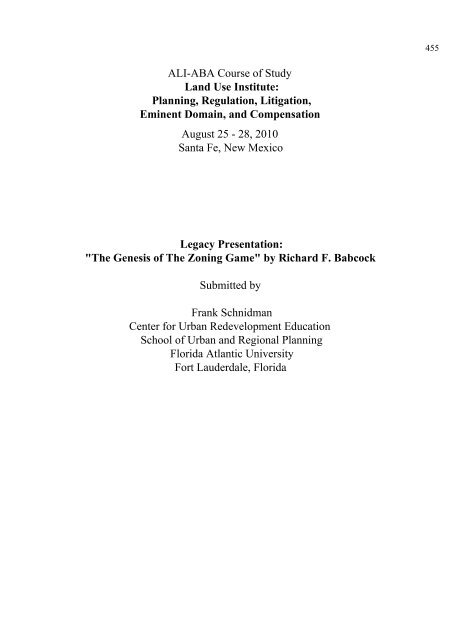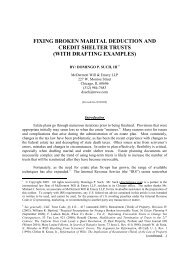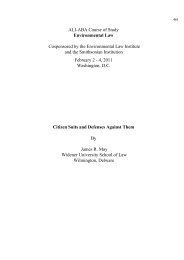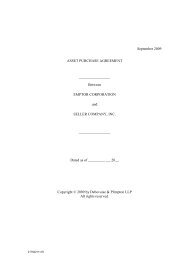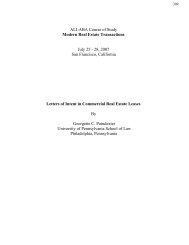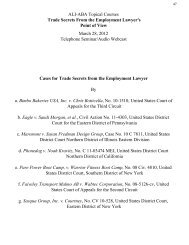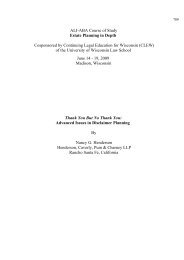ALI-ABA Course of Study Land Use Institute: Planning ... - ALI CLE
ALI-ABA Course of Study Land Use Institute: Planning ... - ALI CLE
ALI-ABA Course of Study Land Use Institute: Planning ... - ALI CLE
You also want an ePaper? Increase the reach of your titles
YUMPU automatically turns print PDFs into web optimized ePapers that Google loves.
455<br />
<strong>ALI</strong>-<strong>ABA</strong> <strong>Course</strong> <strong>of</strong> <strong>Study</strong><br />
<strong>Land</strong> <strong>Use</strong> <strong>Institute</strong>:<br />
<strong>Planning</strong>, Regulation, Litigation,<br />
Eminent Domain, and Compensation<br />
August 25 - 28, 2010<br />
Santa Fe, New Mexico<br />
Legacy Presentation:<br />
"The Genesis <strong>of</strong> The Zoning Game" by Richard F. Babcock<br />
Submitted by<br />
Frank Schnidman<br />
Center for Urban Redevelopment Education<br />
School <strong>of</strong> Urban and Regional <strong>Planning</strong><br />
Florida Atlantic University<br />
Fort Lauderdale, Florida
456<br />
2
457<br />
Legacy Presentation: “The Genesis <strong>of</strong> The Zoning Game”<br />
By Richard F. Babcock<br />
As a result <strong>of</strong> registrants’ suggestions, an annual feature <strong>of</strong> the LUI is<br />
now a video <strong>of</strong> a significant presentation <strong>of</strong> a now-deceased land use<br />
“superstar.” This year's presentation is in response to specific inquiries<br />
by registrants and faculty alike to show the presentation by Richard<br />
Babcock on the early 1960s correspondence, meetings, discussions, and<br />
financial support that led to the preparation <strong>of</strong> The Zoning Game” (1966).<br />
Richard F. Babcock, widely regarded as the dean <strong>of</strong> American planning<br />
lawyers, passed away on September 13, 1993 at the age <strong>of</strong> 76. He was<br />
born November 3, 1917. A prolific author and lecturer, he is perhaps<br />
best remembered for his analysis <strong>of</strong> local land-use practice, The Zoning<br />
Game.<br />
However, for forty years, the name Richard Babcock was synonymous<br />
with national land-use projects, from the American Law <strong>Institute</strong>’s A<br />
Model <strong>Land</strong> Development Code whose advisory committee he chaired,<br />
to the path-breaking HUD report on American cities issued by<br />
Secretary George Romney. Zoning in dozens <strong>of</strong> cities and counties<br />
throughout the United States is better for his deft drafting touch.<br />
Dozens <strong>of</strong> lawyer/planners left his tutelage in the firm that for many<br />
years bore his name to make their own marks in government service,<br />
private practice, and teaching. Babcock was a graduate <strong>of</strong> Dartmouth<br />
College (A.B. magna cum laude, Phi Beta Kappa, 1940), the University<br />
<strong>of</strong> Chicago Law School (J.D., cum laude, Order <strong>of</strong> Coif, 1946), and the<br />
University <strong>of</strong> Chicago School <strong>of</strong> Business (M.B.A., 1950). He was a<br />
member <strong>of</strong> the Illinois Bar and the American <strong>Institute</strong> <strong>of</strong> Certified<br />
Planners.<br />
The 2010 Legacy presentation was given on June 13, 1984 in<br />
Cambridge, Massachusetts at the seminar, “The Zoning Game-<br />
Revisited.” This seminar was sponsored by the Lincoln <strong>Institute</strong> <strong>of</strong><br />
<strong>Land</strong> Policy and the Massachusetts <strong>Institute</strong> <strong>of</strong> Technology Center for<br />
Real Estate Development, and was the first public discussion <strong>of</strong> the<br />
results <strong>of</strong> more that two years <strong>of</strong> research and analysis that would result<br />
in the 1985 book, The Zoning Game—Revisited. Babcock opened the<br />
seminar with a review <strong>of</strong> how the first book came to be written, and it<br />
is those remarks 26 years ago that is this year’s Legacy Presentation.<br />
Introduction and Commentary by Frank Schnidman
458<br />
Reprinted with permission from <strong>Planning</strong> & Environmental Law,<br />
copyright 2008 by the American <strong>Planning</strong> Association<br />
American <strong>Planning</strong> Association<br />
<strong>Planning</strong> & Environmental Law<br />
May 2008 Vol. 60, No. 5 | p.3<br />
Commentary<br />
Richard F. Babcock, widely regarded as the dean <strong>of</strong> American planning lawyers, passed away September 13, 1993. A prolific author and<br />
lecturer, Dick Babcock is perhaps best remembered for his quintessential analysis <strong>of</strong> local land use practice, The Zoning Game (1966),<br />
upon which a generation <strong>of</strong> planners and land use lawyers cut their teeth. He followed with many other important works, including The<br />
Zoning Game Revisited (1985). For 40 years, the name Richard Babcock was synonymous with national land use projects, from the<br />
American Law <strong>Institute</strong>’s “A Model <strong>Land</strong> Development Code,” whose advisory committee he chaired, to the pathbreaking HUD report on<br />
American cities issued by Secretary George Romney. Dozens <strong>of</strong> lawyer–planners left his tutelage in the firm that bore his name and made<br />
their own marks in government service, private practice, and teaching.<br />
Dick Babcock was a graduate <strong>of</strong> Dartmouth College (A.B. magna cum laude, Phi Beta Kappa, 1940); the University <strong>of</strong> Chicago Law<br />
School (J.D., cum laude, Order <strong>of</strong> the Coif, 1946); and the University <strong>of</strong> Chicago School <strong>of</strong> Business (M.B.A., 1950). He was a member <strong>of</strong><br />
the Illinois Bar and the American <strong>Institute</strong> <strong>of</strong> Certified Planners, and president <strong>of</strong> the American <strong>Planning</strong> Association from 1971 to 1972.<br />
While defending the usefulness <strong>of</strong> zoning, he criticized its inept administration and mindless enforcement. Babcock wrote: “I believe that public<br />
regulation <strong>of</strong> private use <strong>of</strong> land is worth reforming—saving, if you please. There is little evidence in the history <strong>of</strong> land development in<br />
America that the private decision-maker, left to his own devices, can be trusted to act in the public interest.” Babcock ranks among the rarefied<br />
leaders <strong>of</strong> the 20th century whose imprint on the field <strong>of</strong> planning and land use law is undisputed. We have asked three <strong>of</strong> his former<br />
colleagues and friends to reminisce about Babcock and his contributions to the planners and land use lawyers <strong>of</strong> the 21st century.<br />
Richard F. Babcock:<br />
The Zoning Game’s Troubadour<br />
The Early Years<br />
Fred Bosselman, FAICP<br />
Dick Babcock’s interest in planning<br />
and zoning was first exhibited during<br />
his University <strong>of</strong> Chicago law school<br />
years in the early 1940s. The optimism<br />
triggered by the Euclid 1 decision had<br />
given way to sharp declines in land values,<br />
producing a decade <strong>of</strong> minimal<br />
building activity. Local governments’<br />
big plans <strong>of</strong> the 1920s were replaced by<br />
a hope that someone would build<br />
something somewhere—anywhere.<br />
Even as a law student, he knew that<br />
to discover how zoning really worked<br />
he would need to dig under the plans<br />
and ordinances and find out what was<br />
actually happening in the field. Empir -<br />
i cal research <strong>of</strong> this type was not yet<br />
common in law schools, but was encouraged<br />
by the growing interest in<br />
“legal realism.” His law review note,<br />
“Amortization <strong>of</strong> Property <strong>Use</strong>s Not<br />
Conforming to Zoning Regulations,” 2<br />
was the result <strong>of</strong> extensive interviews<br />
and examination <strong>of</strong> local records.<br />
This insistence on digging out the<br />
real facts became a hallmark <strong>of</strong><br />
Babcock’s work throughout his career.<br />
Although he carefully read and analyzed<br />
the legal materials, he was never<br />
satisfied until he was sure he knew<br />
what was happening on the ground. It<br />
was this careful reporting <strong>of</strong> actual<br />
events that helped give wide appeal to<br />
his later writing.<br />
Another characteristic manifested in<br />
his first writing was an ability to analyze<br />
issues from a broad perspective.<br />
The title <strong>of</strong> his note sounded like it<br />
was a narrow analysis <strong>of</strong> a particular<br />
legal issue—the kind <strong>of</strong> topic that law<br />
students were usually encouraged to<br />
undertake. But in fact, the note undertook<br />
a comprehensive analysis <strong>of</strong> the<br />
reasons why zoning was not working<br />
the way its proponents had anticipated.<br />
He criticized “overzoning a city for<br />
commercial and industrial uses,” “numerous<br />
[amendments] that affect a few<br />
small lots,” and the rampant grant <strong>of</strong><br />
“use variances,” and he backed up the<br />
criticism with careful documentation. 3<br />
Fred Bosselman teaches at Chicago-Kent College <strong>of</strong> Law. He was an associate<br />
and partner <strong>of</strong> Richard Babcock from 1959 to 1983 and is a reporter<br />
for <strong>Planning</strong> & Environmental Law.<br />
1. Village <strong>of</strong> Euclid v. Ambler<br />
Realty Co., 272 U.S. 365<br />
(1926).<br />
2. 9 U. OF CHI. L. REV. 477<br />
(1942). As was typical <strong>of</strong> law reviews<br />
<strong>of</strong> that period, the note’s<br />
author is not named. The issue<br />
lists Babcock as an associate<br />
editor “in service with the<br />
armed forces <strong>of</strong> the United<br />
States.” at 477.<br />
3. 9 U. <strong>of</strong> Chi. L. Rev. 477, 486–<br />
494.


